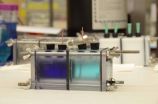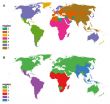Is a brace necessary for spinal fracture healing?
Patients with spinal compression fractures who wore no brace fared as well as patients instructed to wear a brace for treatment
2014-12-03
(Press-News.org) ROSEMONT, Ill.--Compression fractures in the spine due to osteoporosis, a common condition causing progressive bone loss and increased fracture risk, are especially common in older women. A new study appearing in the December 3rd issue of the Journal of Bone & Joint Surgery (JBJS) found that patients who wore a brace as treatment for a spinal compression fracture had comparable outcomes in terms of pain, function and healing when compared to patients who did not wear a brace.
Nearly 700,000 men and women suffer from a spinal compression fracture each year. These fractures, which for the most part are stable fractures occurring on the front or anterior of the spine, are nearly twice as common as other fractures typically linked to osteoporosis such as broken hips and wrists. Women are at greater risk with more than 30 percent age 70 or older suffering at least one osteoporosis-related spinal fracture. Many patients with these fractures are instructed to wear a soft or rigid brace to stabilize the spine with the intent of reducing pain and preventing further deterioration and collapse of the fracture site. However, patients often find the braces uncomfortable, and as a result, do not wear the braces consistently. In addition, prolonged use may result in muscular atrophy (muscle deterioration due to lack of use), deconditioning, skin irritation, as well as additional costs and delays in rehabilitation.
In a Korean study, 60 patients (age 65 and older) with acute osteoporotic compression fractures were randomly assigned within three days of injury to wear a soft brace, a rigid brace or no brace. Outcomes then were measured at 12 weeks using Oswestry Disability Index (ODI) scoring, a common method for determining levels of pain and mobility in orthopaedic patients.
The mean adjusted ODI scores in the no brace and soft brace groups were 35.95 and 37.83, respectively. Similarly, the mean adjusted ODI score in the no brace and rigid brace groups were 35.95 and 33.54, respectively. In addition:
The overall ODI Visual Analog Pain Scale (VAS) scores that measure lower back pain and anterior (front) body compression ratios (the length of the spine) did not differ significantly among the groups after 12 weeks.
The ODI and VAS scores for back pain significantly improved with time after the fractures, and the body compression ratios significantly decreased with time in all three groups.
There was no difference in the compression ratio, as seen on radiographic image; general health status; and patient satisfaction rates among the three groups.
Short Form 36 (SF-36) health survey scores--which measure physical, emotional, social and mental health--decreased at 12 weeks following compression fractures in all groups, confirming previous study findings which found a decrease in life quality following a compression fracture.
"In addition to the cost and discomfort associated with braces, the findings in this study suggest that brace treatment for osteoporotic compression fractures may not provide any additional improvement in fracture healing, mobility and pain," said Ho-Joong Kim, MD, PhD, orthopaedic surgeon and assistant professor, Seoul National University College of Medicine.
"Moreover, the gradual deterioration in life quality, including mental and social wellbeing, associated with this condition reemphasizes the need for prevention of osteoporotic compression and other fractures," said Dr. Kim.
INFORMATION:
Study Details
Sixty patients with acute level one osteoporotic compression fractures were randomly assigned to no brace, soft brace or rigid brace groups within three days of their injury. Baseline data was collected, including sex, birth date, height, weight, smoking status and medication use. The primary outcome was the baseline adjusted Oswestry Disability Index (ODI) score at 12 weeks after compression fracture. The ODI was based on a self-administered questionnaire measuring specific spine (back) function. Secondary outcome measures included ODI score, visual analog scale (VAS) score for back pain, general health status, progression of the body compression ratio over all follow-up assessments and treatment satisfaction at 12 weeks following the compression fracture. General health status was assessed using the Short Form-36 (SF-36) health survey.
Disclosure: One or more of the authors received payments or services, either directory or indirectly (i.e., via his or her institution), from a third party in support of an aspect of this work. None of the authors, or their institution(s), have had any financial relationship in the 36 months prior to submission of this work, with any entity in the biomedical area that could be perceived to influence or have the potential to influence what is written in this work. In addition, no author has had any other relationships, or has engaged in any other activities, that could be perceived to influence or have the potential to influence what is written in this work. In addition, no author has had any other relationships, or has engaged in any other activities, that could be perceived to influence or have the potential to influence what is written in this work.
American Academy of Orthopaedic Surgeons (AAOS) on Facebook, Twitter and Google+
ELSE PRESS RELEASES FROM THIS DATE:
2014-12-03
People who work around the clock could actually be setting themselves back, according to Virginia Tech biologists.
Researchers found that a protein responsible for regulating the body's sleep cycle, or circadian rhythm, also protects the body from developing sporadic forms of cancers.
"The protein, known as human period 2, has impaired function in the cell when environmental factors, including sleep cycle disruption, are altered," said Carla Finkielstein, an associate professor of biological sciences in the College of Science, Fralin Life Science Institute affiliate, ...
2014-12-03
The more time you spend getting to and from work, the less likely you are to be satisfied with life, says a new Waterloo study.
Published in World Leisure Journal, the research reveals exactly why commuting is such a contentment killer--and surprisingly, traffic isn't the only reason to blame.
"We found that the longer it takes someone to get to work, the lower their satisfaction with life in general," says Margo Hilbrecht, a professor in Applied Health Sciences and the associate director of research for the Canadian Index of Wellbeing.
While commuting has long been ...
2014-12-03
Is your inbox burning you out? Then take heart - research from the University of British Columbia suggests that easing up on email checking can help reduce psychological stress.
Some of the study's 124 adults -- including students, financial analysts medical professionals and others -- were instructed to limit checking email to three times daily for a week. Others were told to check email as often as they could (which turned out to be about the same number of times that they normally checked their email prior to the study).
These instructions were then reversed for ...
2014-12-03
RIVERSIDE, Calif. - Geckos, found in places with warm climates, have fascinated people for hundreds of years. Scientists have been especially intrigued by these lizards, and have studied a variety of features such as the adhesive toe pads on the underside of gecko feet with which geckos attach to surfaces with remarkable strength.
One unanswered question that has captivated researchers is: Is the strength of this adhesion determined by the gecko or is it somehow intrinsic to the adhesive system? In other words, is this adhesion a result of the entire animal initiating ...
2014-12-03
An efficient method to harvest low-grade waste heat as electricity may be possible using reversible ammonia batteries, according to Penn State engineers.
"The use of waste heat for power production would allow additional electricity generation without any added consumption of fossil fuels," said Bruce E. Logan, Evan Pugh Professor and Kappe Professor of Environmental Engineering. "Thermally regenerative batteries are a carbon-neutral way to store and convert waste heat into electricity with potentially lower cost than solid-state devices."
Low-grade waste heat is an ...
2014-12-03
New Rochelle, NY, December 3, 2014--Hereditary angioedema (HAE), a rare genetic disease that causes recurrent swelling under the skin and of the mucosal lining of the gastrointestinal tract and upper airway, usually first appears before 20 years of age. A comprehensive review of the therapies currently available to treat HAE in adults shows that some of these treatments are also safe and effective for use in older children and adolescents. Current and potential future therapies are discussed in a Review article in a special issue of Pediatric Allergy, Immunology, and Pulmonology, ...
2014-12-03
Typhoon Hagupit continues to intensify as it continued moving through Micronesia on Dec. 3 triggering warnings. NASA's Aqua satellite passed overhead and captured an image of the strengthening storm while the Rapidscat instrument aboard the International Space Station provided information about the storm's winds.
The International Space Station-RapidScat instrument monitors ocean winds to provide essential measurements used in weather predictions, including hurricanes. "RapidScat measures wind speed and direction over the ocean surface and captured an image of Hagupit ...
2014-12-03
This news release is available in French.
Quebec City, December 3, 2014--Researchers at Université Laval's Faculty of Science and Engineering and Centre for Optics, Photonics and Lasers have developed smart textiles able to monitor and transmit wearers' biomedical information via wireless or cellular networks. This technological breakthrough, described in a recent article in the scientific journal Sensors, clears a path for a host of new developments for people suffering from chronic diseases, elderly people living alone, and even firemen and police officers.
A ...
2014-12-03
Researchers at North Carolina State University have for the first time mapped human disease-causing pathogens, dividing the world into a number of regions where similar diseases occur.
The findings show that the world can be separated into seven regions for vectored human diseases - diseases that are spread by pests, like mosquito-borne malaria - and five regions for non-vectored diseases, like cholera.
Interestingly, not all of the regions are contiguous. The British Isles and many of its former colonies, such as the United States and Australia, have similar diseases ...
2014-12-03
Good news on the panda front: Turns out they're not quite as delicate - and picky - as thought.
Up until now, information gleaned from 30 years worth of scientific literature suggested that pandas were inflexible about habitat. Those conclusions morphed into conventional wisdom and thus have guided policy in China. But a Michigan State University (MSU) research associate has led a deep dive into aggregate data and emerged with evidence that the endangered animal is more resilient and flexible than previously believed.
Vanessa Hull is a postdoctoral research associate ...
LAST 30 PRESS RELEASES:
[Press-News.org] Is a brace necessary for spinal fracture healing?
Patients with spinal compression fractures who wore no brace fared as well as patients instructed to wear a brace for treatment





